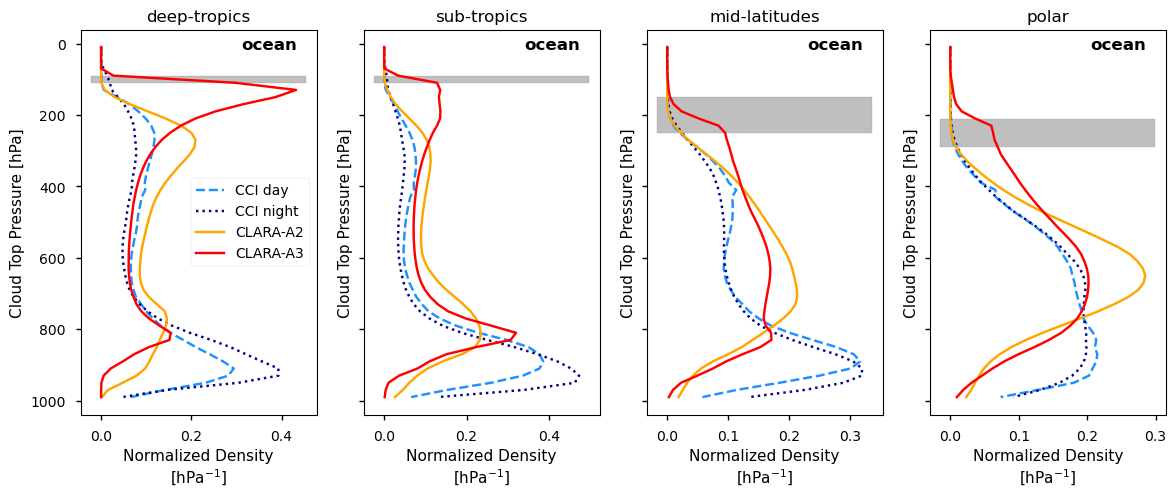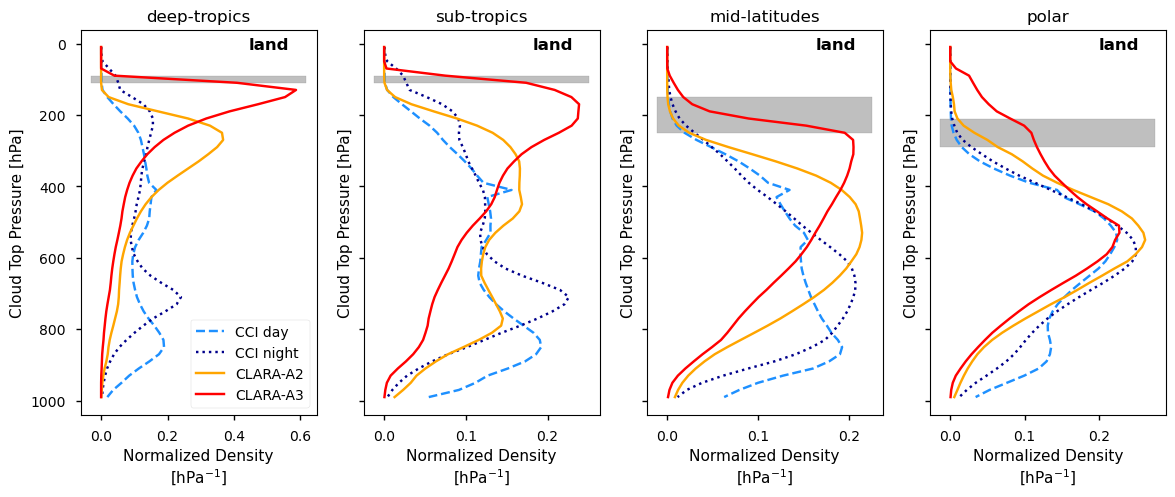
1.1.1. Cloud Type Determination by Altitude for Analyzing Cloud Radiative Effects#
Production date: 23-10-2024, modified 12-06-2025, finalized 25-09-2025
Produced by: CNRS
🌍 Use case: Intercomparison of cloud top altitude distributions from satellite retrievals#
❓ Quality assessment question:#
How does cloud top pressure vary between climate zones, and which dataset provides the most realistic distribution?
Clouds are fundamental regulators of the Earth’s climate system, significantly influencing the planet’s radiative budget, hydrological cycle, and global circulation. These factors, in turn, play a crucial role in shaping ecosystems, agriculture, water resources, and weather patterns. The overall impact of clouds on Earth’s climate is determined by various properties, including cloud height, amount, thickness, and microphysical characteristics. Given their substantial influence on climate, cloud properties are extensively studied, both in the present context and in relation to their evolution under climate change. The following notebook focuses on the cloud height.
High and low clouds have distinct atmospheric radiative effects due to differences in temperature, thickness, and composition. High clouds strongly trap outgoing longwave infrared radiation from the Earth’s surface, and they allow most shortwave solar radiation to pass when they are thin. This leads to a net warming effect on both the surface and the atmosphere. In contrast, low clouds reflect a significant portion of incoming solar radiation back into space, producing a cooling effect.
This analysis utilizes cloud observations from the dataset Cloud properties global gridded monthly and daily data from 1979 to present derived from satellite observations, available at the Climate Data Store. Two complementary Thematic Climate Data Records of cloud properties are provided from two families: CLARA (CM SAF cLoud, Albedo and surface Radiation) and CCI (Climate Change Initiative). These data differ in temporal sampling and horizontal resolution, and three distinct products are available: The two retrieval versions, CLARA-A2 and CLARA-A3, use AVHRR (Advanced Very High Resolution Radiometer) observations, while the CCI product is derived from ATSR2 (Along Track Scanning Radiometer) and AATSR (Advanced ATSR), only covering the period 1995-2012. A CCI intermediate climate data record is available from 2017 onwards, using SLSTR (Sea and Land Surface Temperature Radiometer). The latter is not yet homogenized with the earlier data. Therefore, it is not used in this analysis.
CLARA-A2, CLARA-A3, and CCI, use different methods to retrieve cloud properties. This notebook presents a comparative analysis of their cloud top pressure estimates, both among themselves and against other satellite data [1]. These datasets also provide cloud top temperature and altitude. This analysis focuses on cloud-top pressure, as it is directly retrieved. The other variables are derived from cloud top pressure by using atmospheric profiles, obtained from meteorological reanalyses.
📢 Quality assessment statement#
It is important to note that passive remote sensing has limitations: it provides a top-down perspective, which does not account for hidden cloud layers, and it estimates a ‘radiative’ cloud height. This radiative height can be several kilometers below the actual cloud top, especially in cases where clouds have diffuse tops, with optical depth gradually increasing from the top down over a significant vertical range. This phenomenon is relevant for approximately 70% of high clouds in the tropics and 30-40% of high clouds in the midlatitudes [2].
These are the key outcomes of this assessment
All datasets show more low-level clouds over ocean than over land, as expected.
The CCI dataset produces by far the least realistic cloud top height distributions among the evaluated products, by strongly underestimating the amount of high-level clouds (no peak in the upper troposphere). Since the channels of the AATSR and AVHRR instruments are similar, the reason lies in the retrieval method, based on optimal estimation and the assumption of a single layer cloud. The retrieved cloud top pressure is an effective one, defined by infrared radiation. In the case of semi-transparent cirrus, this height should lie much below the cloud top, depending on the optical depth of the cloud. Furthermore, during daytime, the combined use of infrared and visible radiances may lead to a cloud height underestimation due to underlying lower cloud layers.
The two retrieval versions of the CLARA product lead to very different results. While the A2 version uses a classical retrieval approach, based on radiative transfer, the A3 version uses a neural network approach trained with active lidar data from CALIPSO. This leads to retrievals of ‘radiative’ cloud height for CLARA-A2 and cloud top height for CLARA-A3. However, the CLARA-A3 product seems to identify also very thin (sub-visible) cirrus clouds above the tropopause layer, which a passive sensor like AVHRR should not be able to detect, in particular stratospheric clouds in polar regions over land.
The CLARA-A2 cloud top pressure of high clouds peaks in the tropics at about 250 hPa. Towards higher latitudes, this peak moves towards larger pressure (lower height). The distributions are bimodal over tropical ocean and in the subtropics. The height of low-level clouds over ocean may be slightly overestimated (800 instead of 850 hPa).
Compared to CLARA-A2, the CLARA-A3 cloud top pressure peaks around 800 hPa are slightly narrower, while the peaks in the upper troposphere are much more pronounced and at a much higher altitude (150 hPa to 220 hPa in the tropics and subtropics). Yet, at polar latitudes, the CLARA-A3 distributions have still only a single peak in the middle troposphere, and over polar land a non-negligible amount of clouds above the tropopause.
In general, the grid cell cloud top pressure uncertainty distributions are broader for low-level clouds than for high-level clouds. Furthermore, the CLARA-A3 cloud top pressure uncertainty is larger over land than over ocean, in particular for low-level clouds. For CCI, the uncertainty distributions are narrower during nighttime than during daytime (additional use of VIS channels) for high-level clouds, while they are more similar for low-level clouds.
According to the description in the files, CCI only provides an effective cloud top defined by IR radiation. This height may considerably underestimate the real cloud height. The provided grid-cell cloud top pressure uncertainty of the identified high-level clouds is very small, with most values around 2 to 10 hPa. This indicates that the clouds which are identified as high-level clouds are those for which the retrieval is more certain, as for high opaque clouds.
The CLARA-A3 high-level cloud top uncertainty distributions peak around 10 to 20 hPa over the whole globe, and uncertainties above 50 hPa are negligible. The distributions broaden towards the polar regions for CLARA-A3, as one would expect, whereas the CCI uncertainties are the smallest in the polar regions. The low-level cloud top uncertainty distributions are much broader, in particular over land. CLARA-A2 does not provide uncertainty estimates.
📋 Methodology#
The analysis comprises the following steps:
Choose the parameters to use and setup code
Import the relevant libraries. Define the parameters of the analysis and set the dataset requests.
Download the data and check quality
Download the satellite products of daily mean cloud top pressure and its uncertainty.
Check the quality status of the CLARA-A3 data.
Prepare the datasets for the analysis, selecting four different latitude bands
Include the land mask into the datasets and include climatological limits of the tropopause for the different latitude bands
Plot the cloud top pressure distributions for selected latitude bands, separately over ocean and over land
Plot the cloud top pressure uncertainty distribution for the daytime observation of the CCI product
Plot the cloud top pressure uncertainty distributions for CLARA-A3 and CCI nighttime observations separately for the selected latitude bands
📈 Analysis and results#
Choose the parameters to use and setup code#
This section includes the library imports and the parameter settings for the analysis.
Import libraries#
Set parameters#
Download the data and check quality#
Define request#
Functions to cache#
Show CLARA-A3 quality#
Number of records with status 0: 365
Number of records with status 1: 0
Number of records with status 2: 0
Download and transform#
product='CCI' region='deep-tropics'
product='CCI' region='sub-tropics'
product='CCI' region='mid-latitudes'
product='CCI' region='polar'
product='CLARA-A2' region='deep-tropics'
product='CLARA-A2' region='sub-tropics'
product='CLARA-A2' region='mid-latitudes'
product='CLARA-A2' region='polar'
product='CLARA-A3' region='deep-tropics'
product='CLARA-A3' region='sub-tropics'
product='CLARA-A3' region='mid-latitudes'
product='CLARA-A3' region='polar'
product='CCI' region='deep-tropics'
product='CCI' region='sub-tropics'
product='CCI' region='mid-latitudes'
product='CCI' region='polar'
product='CLARA-A3' region='deep-tropics'
product='CLARA-A3' region='sub-tropics'
product='CLARA-A3' region='mid-latitudes'
product='CLARA-A3' region='polar'
Results#
Cloud top pressure#


Figure 1: Normalized cloud top pressure distributions over ocean (top) and over land (bottom), separately for deep-tropics, sub-tropics, mid-latitudes and polar regions during the period of interest. Compared are results derived from CLARA-A2, CLARA-A3 and CCI (day and night). Tropopause levels (depending on season) are shown as gray bands. The tropopause shifts from about 100 hPa (~17 km) in the tropics to 250 hPa (~9 km) in the polar regions.
The figure above compares normalized cloud top pressure distributions derived from CLARA-A2, CLARA-A3 and CCI (day and night). These normalized distributions provide a view from above, without accounting for hidden cloud layers beneath the top layer. While several features are consistent across the three datasets, others show notable differences. In the following, these distributions are compared with the results from the GEWEX cloud assessment [1] to estimate which dataset offers the most realistic representation.
The GEWEX cloud assessment indicates that cloud top pressure distributions over oceans exhibit a bimodal pattern in tropical regions, with pronounced peaks in the upper and lower troposphere. These strong peaks decrease in intensity as one moves toward the polar regions. Over land, the contribution of single-layer low-level clouds is minimal. Moreover, the cloud tops of high clouds are high in the tropics and gradually lower toward the poles following the tropopause.
The CLARA-A2 dataset correctly captures two distinct peaks in cloud density over tropical oceans, corresponding to high and low cloud layers. These peaks converge into the mid-troposphere as they approach polar regions. Over land, the cloud density peaks at high altitudes in the tropics, with this peak becoming broader and shifting to lower altitudes toward the poles. The updated GEWEX cloud assessment includes several cloud datasets provided by the Cloud-Aerosol Lidar and Infrared Pathfinder Satellite Observation (CALIPSO) Science Team [5], one mimicking the sensitivity of passive remote sensing [1]. With respect to this dataset (CALIPSO-passive), the height of low-level clouds given by CLARA-A2 is slightly overestimated (800 instead of 850 hPa), while the height of high-level clouds is underestimated. The latter is expected, since the active lidar of CALIPSO determines the cloud top, while a classical cloud retrieval using (passive) radiometers, yields a ‘radiative’ cloud height, which is below the cloud top, in particular for diffuse cloud tops which are frequent in the tropics [2]. It should be noted that the CLARA-A2 version displayed in [1] is an earlier version than the one provided in the CDS (versions 2.0 and 2.1, respectively).
The CLARA-A3 dataset also depicts two distinct peaks in cloud density over tropical oceans, associated with high and low clouds. These peaks are more pronounced and narrower, particularly in the high troposphere. Over land, CLARA-A3 shows a significant peak of high clouds in the tropics, which becomes less prominent at polar latitudes as the mid-level cloud presence increases. The cloud top pressure retrieval for CLARA-A3 is based on a neural network trained on CALIPSO cloud data. Consequently, the CLARA-A3 product also includes very thin cirrus clouds in the tropopause layer, which a passive sensor like AVHRR is not able to detect, in particular stratospheric clouds in polar regions over frozen land. Compared to CALIPSO results in [1], low-level clouds over ocean have slightly higher cloud tops (800 instead of 850 hPa), as CLARA-A2, but the peaks are narrower than for CLARA-A2.
The CCI product only provides cloud top pressure data separately for daytime and nighttime. Both provide similar distributions over ocean, with slightly less high and more low clouds during nighttime. Over land during nighttime the distributions reveal slightly more high clouds and the peak of low-level clouds is shifted to about 700 hPa, compared to 900 hPa during daytime. Furthermore, the distributions of cloud top pressure differ significantly from those of the CLARA products and those deduced from similar instruments as shown in Figure 6 of [1]. The CCI product overestimates the relative occurrence of low clouds and strongly underestimates the relative occurrence of high clouds, both over land and ocean, especially over tropical and mid-latitude regions. In particular, the expected high-altitude peak in the tropics is nearly negligible. Overall, these cloud top pressure distributions are the least realistic among the products evaluated.
Cloud top pressure uncertainty#
In this subsection, we compare the CCI and CLARA-A3 uncertainty estimates for the gridded daily-mean cloud top pressures. Both datasets provide different estimates of the uncertainty:
the average footprint retrieval uncertainty,
the grid cell uncertainty, assuming a correlation of 0.1 between footprint uncertainties to acknowledge that the retrieval errors have some shared component (e.g. from calibration, forward radiative transfer model, assumed atmosphere). This uncertainty is in general larger than the grid-mean uncertainty, but smaller than the average footprint retrieval uncertainty. The latter two are different by a factor of 1/sqrt(N), with N the number of cloudy footprints within the grid cell.
We use the grid cell cloud top uncertainty, as we have used the grid cell averages of the cloud top pressure in Figure 1. For the CCI dataset, the uncertainty, as the cloud top pressure, is provided separately for daytime and nighttime. In the following, we compare distributions of these uncertainties separately for high-level (cloud top pressure < 440 hPa) and for low-level clouds (cloud top pressure > 680 hPa), for the same latitude bands over ocean and over land, as the cloud top pressure distributions displayed in Figure 1.


Figure 2: Distribution of cloud top pressure uncertainty for high-level and low-level clouds over ocean (top) and over land (bottom), in the by deep tropics, subtropics, mid-latitudes, and polar regions during the period of interest. The presented maximum density in the plots is limited to 35%, while CCI night high-level cloud top pressure uncertainty reaches 60 to 70% in the polar regions.
In general, the cloud top pressure uncertainty distributions are broader for low-level clouds than for high-level clouds. Furthermore, the CLARA-A3 cloud top pressure uncertainty is larger over land than over ocean, in particular for low-level clouds. For CCI, the uncertainty distributions are narrower during nighttime than during daytime (additional use of VIS channels) for high-level clouds, while they are more similar for low-level clouds.
The distributions of high-level cloud top pressure uncertainty peak around 10 to 20 hPa for CLARA-A3 and around 2 to 10 hPa for CCI. High-level cloud top pressure uncertainties above 50 hPa are negligible.The distributions broaden towards the polar regions for CLARA-A3, as one would expect, whereas the CCI uncertainties are the smallest in the polar regions.
The uncertainty distributions for low-level clouds in general peak at slightly lower values than the ones for high-level clouds, but the distributions themselves are much broader, in particular over land. A secondary peak over subtropical land around 110 hPa is due to grid cells with only a few cloudy observations. The CCI distributions often peak near 0 hPa, which seems unrealistic.
Considering the CCI cloud top pressure distributions, with very few identified high-level clouds compared to the results from other datasets, and the CCI very small uncertainties of the high-level clouds, this indicates that CCI mostly identifies high-level clouds for which the uncertainty is small, like high opaque clouds.
ℹ️ If you want to know more#
Key resources#
Some key resources and further reading were linked throughout this assessment.
The CDS catalogue entry for the data used is:
Cloud properties global gridded monthly and daily data from 1979 to present derived from satellite observations: https://cds.climate.copernicus.eu/datasets/satellite-cloud-properties?tab=overview
Code libraries used:
C3S EQC custom functions,
c3s_eqc_automatic_quality_control, prepared by B-Open
The GEWEX Cloud Assessment:
The Global Energy and Water Exchanges (GEWEX) program is a core project of the World Climate Research Programme (WCRP). The first GEWEX Cloud Assessment was published in 2012 and it provided the first coordinated inter-comparison of publicly available, global cloud products [3-4]. The database associated with the GEWEX Cloud Assessment has revealed its usefulness for the assessment of new datasets. Since in the last decade existing cloud property retrievals have been revised and new retrievals have been developed, this exercise has been recently repeated with 11 global cloud products derived from measurements of multi-spectral imagers, IR sounders, and lidar [1]. The first cloud assessment included products from ATSR, while the most recent assessment includes CLARA-A2. However, the CLARA-A2 version (V2.1) in the CDS is a later, improved version compared to the one provided in the updated GEWEX cloud assessment (V2.0). The updated cloud assessment database is available at this link.
Reference/Useful material#
[1] Stubenrauch, C.J., Kinne, S., Mandorli, G. et al. Lessons Learned from the Updated GEWEX Cloud Assessment Database. Surv Geophys (2024). https://doi.org/10.1007/s10712-024-09824-0
[2] Liao, X., W. B. Rossow, and D. Rind (1995), Comparison between SAGE II and ISCCP high-level clouds: 2. Locating cloud tops, J. Geophys. Res., 100(D1), 1137–1147, doi:10.1029/94JD02430.
[3] Stubenrauch, C. J., and Coauthors, 2013: Assessment of Global Cloud Datasets from Satellites: Project and Database Initiated by the GEWEX Radiation Panel. Bull. Amer. Meteor. Soc., 94, 1031–1049, https://doi.org/10.1175/BAMS-D-12-00117.1
[4] Stubenrauch CJ, Rossow WB, Kinne S, GEWEX Cloud Assessment Team (2012) Assessment of Global Cloud Datasets from Satellites, A Project of the World Climate Research Programme Global Energy and Water Cycle Experiment (GEWEX) Radiation Panel, WCRP report.
[5] Liu Z, Kar J, Zeng S, Tackett J, Vaughan M, Avery M, Pelon J, Getzewich B, Lee K-P, Magill B, Omar A, Lucker P, Trepte C, Winker D (2019) Discriminating between clouds and aerosols in the CALIOP version 4.1 data products. Atmos Meas Tech 12:703–734. https://doi.org/10.5194/amt-12-703-2019
